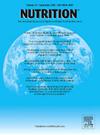Washed microbiota transplantation effectively improves nutritional status in gastrointestinal disease–related malnourished children
IF 3.2
3区 医学
Q2 NUTRITION & DIETETICS
引用次数: 0
Abstract
Background and aim
Gut microbiota dysbiosis plays a critical role in malnutrition caused by food intolerance and intestinal inflammation in children, which needs to be addressed. We assessed the efficacy and safety of washed microbiota transplantation (WMT) for gastrointestinal disease–related malnourished children.
Methods
This was a prospective observational study involving gastrointestinal disease–related malnourished pediatric patients who underwent WMT. The primary outcome was the clinical response rate at 3 mo post-WMT. Clinical response was defined as an improvement in the children's nutritional status of one level or more. The secondary outcomes were changes in gastrointestinal symptoms, laboratory nutritional indicators, and adverse events during the WMT procedure.
Results
29 patients undergoing 74 WMTs were included for analysis. In total, 48.3% (14/29) of patients achieved clinical response post-WMT. Gastrointestinal symptoms, including diarrhea, mucous stool, abdominal pain, abdominal distention, and hematochezia, were significantly relieved post-WMT (all P < 0.05). Serum albumin and prealbumin levels were increased significantly post-WMT (P = 0.028 and 0.028, respectively). Eight self-limiting and transient adverse events, including diarrhea, abdominal pain, and abdominal distension, occurred after WMT.
Conclusion
This study indicated that WMT might be effective and safe for improving nutritional status and gastrointestinal symptoms in gastrointestinal disease–related malnourished children at 3-mo follow-up. WMT was expected to be a new therapeutic option for these patients.
水洗微生物群移植可有效改善与胃肠道疾病相关的营养不良儿童的营养状况。
背景与目的:肠道菌群失调在儿童食物不耐受和肠道炎症引起的营养不良中起着至关重要的作用,这需要得到解决。我们评估了水洗菌群移植(WMT)治疗胃肠道疾病相关营养不良儿童的有效性和安全性。方法:这是一项前瞻性观察性研究,涉及胃肠疾病相关的营养不良儿童患者,他们接受了WMT。主要终点是wmt后3个月的临床缓解率。临床反应被定义为儿童营养状况改善一个或多个水平。次要结局是在WMT过程中胃肠道症状、实验室营养指标和不良事件的变化。结果:29例接受74例wmt的患者纳入分析。总的来说,48.3%(14/29)的患者在wmt后获得了临床缓解。腹泻、黏液便、腹痛、腹胀、便血等胃肠道症状均明显缓解(P < 0.05)。wmt后血清白蛋白和前白蛋白水平显著升高(P分别为0.028和0.028)。WMT后发生了8个自限性和短暂性不良事件,包括腹泻、腹痛和腹胀。结论:本研究提示WMT对改善胃肠道疾病相关营养不良儿童3个月随访时的营养状况和胃肠道症状可能是有效和安全的。WMT有望成为这些患者的一种新的治疗选择。
本文章由计算机程序翻译,如有差异,请以英文原文为准。
求助全文
约1分钟内获得全文
求助全文
来源期刊

Nutrition
医学-营养学
CiteScore
7.80
自引率
2.30%
发文量
300
审稿时长
60 days
期刊介绍:
Nutrition has an open access mirror journal Nutrition: X, sharing the same aims and scope, editorial team, submission system and rigorous peer review.
Founded by Michael M. Meguid in the early 1980''s, Nutrition presents advances in nutrition research and science, informs its readers on new and advancing technologies and data in clinical nutrition practice, encourages the application of outcomes research and meta-analyses to problems in patient-related nutrition; and seeks to help clarify and set the research, policy and practice agenda for nutrition science to enhance human well-being in the years ahead.
 求助内容:
求助内容: 应助结果提醒方式:
应助结果提醒方式:


